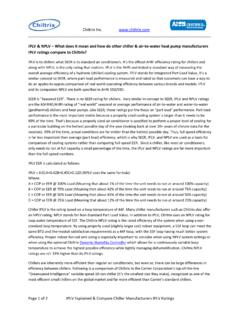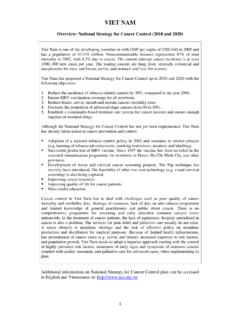Transcription of Applying 2011 ASHRAE data center guidelines to HP ProLiant ...
1 Technical white paper Applying 2011 ASHRAE data center guidelines to HP ProLiant -based facilities Table of contents Introduction 2 ASHRAE guidelines for data center operation 2 How these guidelines affect you 4 How these guidelines affect HP products 5 For more information 5 Click here to verify the latest version of this document. Created December 2012. 2 Introduction data center cooling systems represent a significant portion of a facility s capital expenditure (CAPEX) and use a substantial amount of energy. The American Society of Heating, Refrigerating, and Air-conditioning Engineers ( ASHRAE ) publishes guidelines for temperature and humidity operating ranges of IT equipment.
2 This paper explains the temperature and humidity guidelines that ASHRAE recommends for IT equipment and how these guidelines might benefit data center operators. It also describes how HP products fit within these guidelines . ASHRAE guidelines for data center operation The ASHRAE guidelines for data center operation suggest thermal ranges of operation for IT equipment that are commonly accepted by many data center administrators and facility managers. ASHRAE recently published the book: Thermal guidelines for data Processing Environments, 3rd Ed. (2012), which defines a recommended operating range and four Allowable ranges, designated A1 through A4 (Figure 1). The previous edition (2008) guidelines defined just two classes (1 and 2) that correspond to the new A1 and A2 ranges.
3 The various allowable ranges provide IT equipment manufacturers and data center designers with a simple way to define product specification limits. In the book, ASHRAE stresses that data center operators should plan to keep IT equipment conditions within the recommended range as much as practical. Table 1 lists the operational classes suggested by ASHRAE for IT equipment in data centers. The table only presents temperature and humidity information. For additional parameter information, refer to the ASHRAE book referenced earlier. A1 A2 A3 A4 45 40 35 25 20 15 10 30 5 0 -5 C Recommended Range Figure 1. This illustration shows the 2011 ASHRAE recommended and allowable temperature ranges for data centers.
4 3 The previous (2008) ASHRAE guidelines defined classes 1 and 2 with recommended and allowable envelopes for maintaining high reliability for IT equipment across a broad spectrum of businesses and conditions. The 2011 ASHRAE classes of A1 and A2 retain the 2008 class 1 and 2 definitions (respectively). Classes A3 and A4 have also been added with expanded (allowable) operating ranges ranges that encourage the use of free-cooled, chillerless facilities. As indicated in Table 1, the recommended operating range is the same for all classes. Table 1. 2011 ASHRAE thermal guidelines for data centers Class IT equipment type Recommended operating range Allowable operating range Maximum dew point Environmental control A1 Enterprise servers, storage products 18 to 27 C [1] 15 to 32 C [2] 17 C Tightly controlled A2 Volume servers, storage products, personal computers, workstations Same as above 10 to 35 C [2] 21 C Some control A3 Volume servers, storage products, personal computers, workstations Same as above 5 to 40 C [3] 24 C Some control A4 Volume servers, storage products, personal computers, workstations Same as above 5 to 45 C [4] 24 C Some control NOTES.
5 [1] Dry-bulb temperature, C dew point to 60% relative humidity [2] Dry-bulb temperature, 20 to 80% relative humidity. [3] Dry-bulb temperature, -12 C dew point and 8% to 85% relative humidity. [4] Dry-bulb temperature, -12 C dew point and 8% to 90% relative humidity. Based on the data in Table 1, Figure 2 shows a graphical representation of recommended and allowable operating envelopes defined in the 2011 ASHRAE data center guidelines . Each envelope is defined by four attributes of the air entering the IT equipment: Dry bulb temperature (red gradients) Humidity ratio (grey gradients) Saturation temperature (green gradients) Relative humidity (blue gradients) Note that the recommended envelope is the same for all four operating classes, while the allowable envelope expands for each succeeding class.
6 4 Figure 2. This illustration shows the data center recommended and allowed operating envelopes for ASHRAE classes A1 thru A4. How these guidelines affect you If you are not doing a new build or major renovation, the new ranges defined in the 2011 ASHRAE guidelines should not affect you. The new allowable ranges for classes A3 and A4 are intended to remove obstacles to new data center cooling strategies such as free-cooling methods. Free-cooling takes advantage of a facility s local climate by using outside air to cool IT equipment directly without the use of mechanical refrigeration (chillers or air conditioners) whenever possible. A variety of implementations for free-cooling are possible.
7 For example, filtered outside air can be drawn directly into the data center . Other techniques keep the outside air isolated from the data center but still transfer the data center heat directly to the outside air without refrigerating it. Careful application of the new ASHRAE guidelines may enable free-cooling in more climates or allow for the datacenter to be cooled without refrigeration more days of the year. Reducing the use of refrigerated cooling lowers the operating expenses (OPEX) for the data center and in some cases, the refrigeration equipment can be eliminated or significantly reduced in size, saving capital investment expense (CAPEX) as well. It should be apparent that implementing free-cooling must be done very carefully to guarantee that the IT equipment in the data center can continue to operate under all conditions.
8 Note that the ASHRAE -recommended operating range has not changed and remains constant across all four operating classes. In addition, ASHRAE advises operating IT equipment outside of the recommended range only on a limited basis to avoid impacting the reliability of the IT equipment. Simply raising a cooling system s set point temperature beyond the recommended envelope may have undesirable results, including: Increased fan operation in the IT equipment, offsetting cooling system savings and raising noise levels Warnings/alarms from IT equipment operating at or beyond HP-recommended levels Shortened lifecycle of IT and cooling equipment due to prolonged higher operating temperatures Note: Envelopes define air entering IT equipment operating at sea level.
9 Relative humidity Class A4 Allowable envelope Class A3 Allowable envelope Class A2 Allowable envelope Class A1 Allowable envelope Humidity Ratio grams of moisture per kilogram of dry air 50 40 30 20 10 Dry bulb temperature ( C) 20 15 10 5 0 25 20 15 10 5 0 10% 30% 50% 70% 90% 60% 40% 80% 20% Classes A1-A4 Recommended envelope 0 5 Implementing free-cooling methods generally requires a major renovation to an existing data center or the construction of a new one and careful facility planning. If you are planning such changes, then free-cooling using the new ASHRAE ranges can produce real CAPEX and OPEX savings. If done correctly, the savings can be realized without substantially changing IT lifecycle expectations.
10 If you are not doing a new build or major renovation, the new ranges should not affect you. Contact the HP Critical Facilities Services group for help planning your ideal datacenter. How these guidelines affect HP products HP supports the adoption of less expensive and eco-friendly cooling methods encouraged by the latest ASHRAE guidelines . The HP-developed 134,000 sq. meter Aurora facility in Australia and the 300,000 Wynyard facility in England are designed from the ground up to use free-cooling whenever possible. HP has also developed Performance Optimized Datacenters (PODs) complete facilities in self-contained modules that can achieve industry-leading power usage effectiveness (PUE) ratings.








